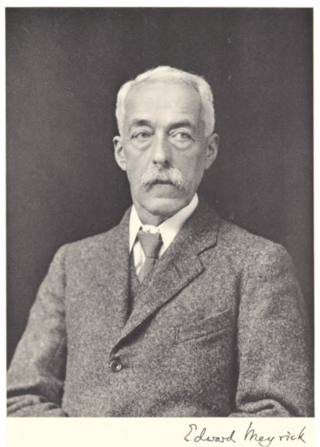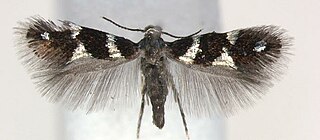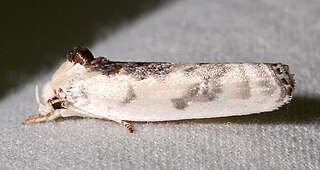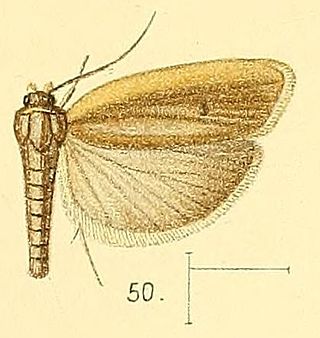Related Research Articles

Edward Meyrick was an English schoolmaster and amateur entomologist. He was an expert on microlepidoptera and some consider him one of the founders of modern microlepidoptera systematics.

The Heliozelidae, commonly known as shield-bearer moths, are a family of small, day flying monotrysian moths distributed worldwide. The larvae of most heliozelid species are leaf miners who cut distinctive shield-shaped cases from the surface of the host leaf, hence the common name. Some species are considered pests of commercial crops such as grapevines, cranberries, and walnuts. The taxonomy of this family is poorly understood.

The Archipini are a tribe of tortrix moths. Since many genera of these are not yet assigned to tribes, the genus list presented here is provisional.
Stigmella xystodes is a moth of the family Nepticulidae first described by Edward Meyrick in 1916. It is found from the Oriental region to the Near East, North Africa and the Canary Islands.

The Autostichinae are a subfamily of moths in the superfamily Gelechioidea. Like their relatives therein, their exact relationships are not yet very well resolved. The present lineage was often included in the concealer moth family (Oecophoridae), but alternatively it is united with the Symmocidae sensu stricto to form an expanded family Autostichidae.

Antaeotricha is a genus of moths. It is the largest genus in the subfamily Stenomatinae, numbering over 400 species in the Western Hemisphere.

Acrocercops is a genus of moths in the family Gracillariidae.
Acrocercops pharopeda is a moth of the family Gracillariidae, known from Karnataka, India. It was described by Edward Meyrick in 1916.

Xyloryctidae is a family of moths contained within the superfamily Gelechioidea described by Edward Meyrick in 1890. Most genera are found in the Indo-Australian region. While many of these moths are tiny, some members of the family grow to a wingspan of up to 66 mm, making them giants among the micromoths.
Hoplophanes is genus of moths of the family Heliozelidae. It was described by Edward Meyrick in 1897.
Scrobipalpa ergasima is a moth of the family Gelechiidae. Edward Meyrick first used the scientific name in 1916. It is found in the Mediterranean Region and on the Canary Islands. Outside of Europe, it is found in Egypt, Saudi Arabia, the Democratic Republic of the Congo, Namibia, South Africa, Sudan, Australia, India, Indonesia, Myanmar and Pakistan.
Meridarchis is a genus of moths in the family Carposinidae erected by Philipp Christoph Zeller in 1867.

The Stenomatinae are a subfamily of small moths in the family Depressariidae.
Heliangara lampetis is a moth in the family Autostichidae. It was described by Edward Meyrick in 1906. It is found in Sri Lanka.
Heliangara macaritis is a moth in the family Autostichidae. It was described by Edward Meyrick in 1910. It is found in India.

Stenoma is a genus of moths. The type species is Stenoma litura, which was described by Philipp Christoph Zeller in 1839.

Antipterna is a genus of moths of the family Oecophoridae, first described by Edward Meyrick in 1916.

Trachypepla is a genus of moths of the family Oecophoridae. It was circumscribed in 1883 by Edward Meyrick. The species within this genus are indigenous to Australia and New Zealand.
References
- ↑ Savela, Markku, ed. (December 2, 2013). "Heliangara ericydes Meyrick, 1916". Lepidoptera and Some Other Life Forms. Retrieved August 31, 2020.
- ↑ Meyrick, Edward (1912–1916). Exotic Microlepidoptera. 1 (18): 573.
 This article incorporates text from this source, which is in the public domain .
This article incorporates text from this source, which is in the public domain .